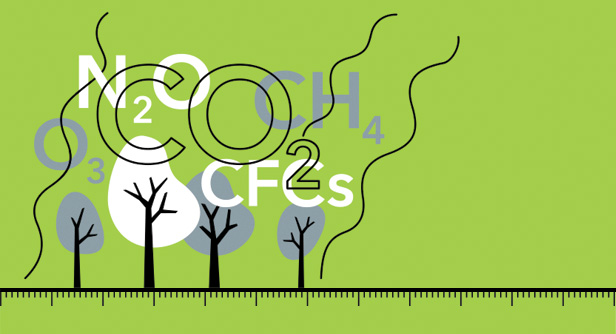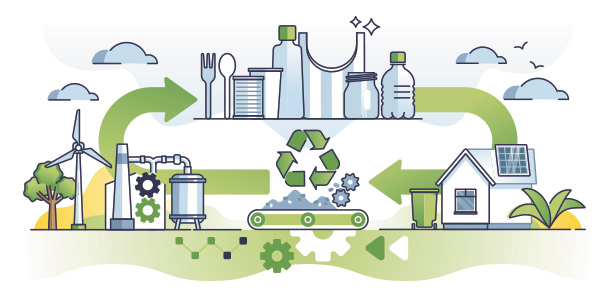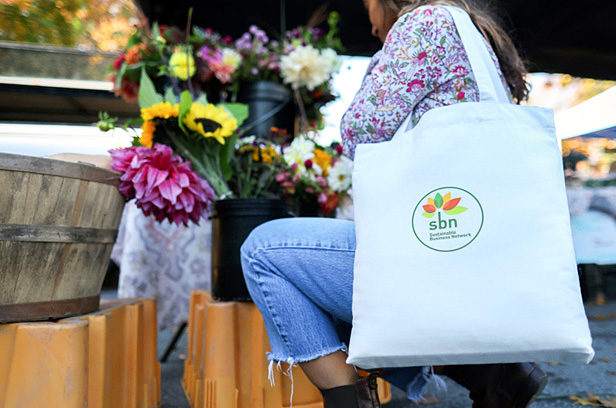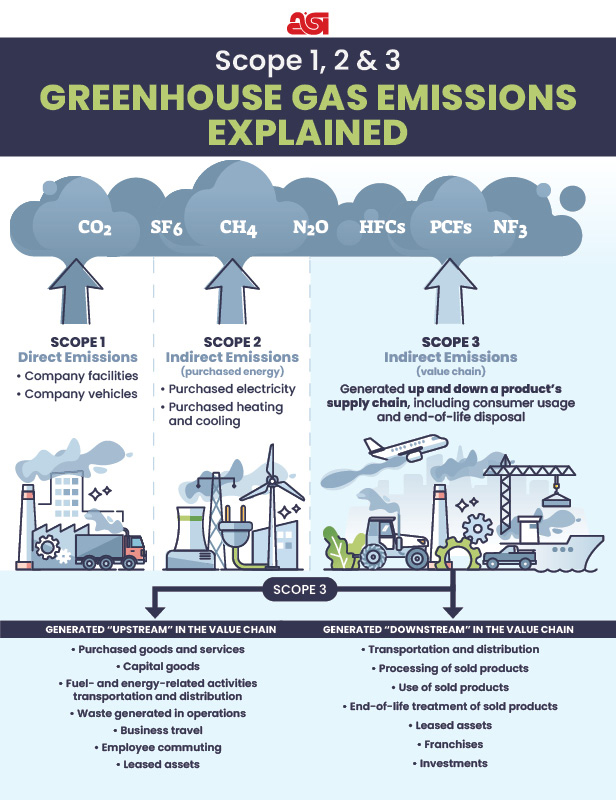Sustainability Last Updated: November 13, 2025
How To Solve Sustainability’s Most Daunting Task: Measuring Scope 3 Emissions
Indirect greenhouse gas emissions up and down the supply chain often have the biggest environmental impact – but are also the hardest to determine.
Sustainability may as well be a four-letter word for Albert van der Veen.
“It’s forbidden in our company because nothing is sustainable in and of itself, but it can have a lower impact,” the CEO of Dutch promotional products supplier XD Connects says, adding that the term “sustainability” is misleading at best and actual greenwashing at worst.

Saying a product is made of coffee grounds, corn, apple peels or some other ostensibly sustainable material sounds nice in marketing copy, van der Veen says, but how can it be proven to have a lower impact throughout its lifespan compared to other products?
The answer, for XD Connects, is by painstakingly tracing the supply chain of each product, with an emphasis on the carbon footprint of each step in the process. The company hired a dedicated team, which spent two years developing an independently verified lifecycle assessment (LCA) tool that calculates the lifetime carbon emissions generated by each of its products – then, crucially, the supplier publishes those emissions, along with price and other specs, in its catalog, so that distributors and their clients can make informed purchasing decisions. (See “What Is a Lifecycle Assessment?” for more.)
“We will never claim something is lower impact if we can’t prove it,” van der Veen says.
View this post on Instagram
XD Connects shares information on the environmental impact for most of its products on its website and via QR-code enabled digital passports.
As more and more brands set goals to reduce greenhouse gas (GHG) emissions and reach carbon neutrality (or even negative carbon emissions) by a certain date, calculating carbon footprints has become increasingly important. For most companies, the easiest place to start is with Scope 1 and Scope 2 emissions. Scope 1 are direct GHG emissions that come from sources controlled or owned by an organization – think company vehicles and equipment. Scope 2 emissions are associated with the purchase of electricity, heating and cooling; though those emissions physically occur at a power plant or other facility, they’re included in an organization’s emissions inventory because they’re a direct result of an organization’s energy use.
Both Scope 1 and 2 emissions are relatively simple to measure and develop reduction plans for. But, the reality is that for most companies, the vast majority of GHG (anywhere from 65% to 95% of a company’s overall carbon impact) are what’s known as Scope 3 emissions. It’s a sort of catchall category that includes any indirect emissions that occur up and down a product’s value chain – beginning at the raw-material stage and extending to when it reaches the end of its useful lifespan. This includes everything from business travel and employee commuting to processing, use and disposal of sold products to transportation and distribution of goods. (See “Scope 1, 2 & 3 Greenhouse Gas Emissions Explained” for a full list.)
“I’m not going to say that Scope 3 is everyone’s biggest category of emissions,” says Victoria Sierra, compliance manager of Top 40 supplier Koozie Group (asi/40480), “but it’s so ethereal that it ends up being hard to get your hands around it. I think it’s one of those things that as it becomes more well known, the tools to track it will become more accessible.”
Tackling Scope 3 emissions in promotional products can be a daunting prospect, but it’s a worthy endeavor. Lowering emissions is not only a net good for the earth, but many clients – particularly Fortune 500 behemoths – are requiring such metrics to calculate their own carbon footprints. This is often at the behest of looming government regulations: Though Reuters recently reported that the Securities and Exchange Commission dropped Scope 3 reporting requirements from corporate climate risk rules it’s drafting, the European Union is rolling out sustainability reporting requirements this year, and companies that do business in California will need to report their Scope 3 emissions beginning in 2027. Not having a handle on emissions could hamstring a promo business.
“It’s not impossible, but it certainly requires a significant commitment,” says Lou Elliott-Cysewski, a member of the Promo for the Planet Advisory Board and co-founder and CEO of CoolPerx (asi/556047) in Bellevue, WA. “You, as a business owner, have to stick to a set of values in which you’ll operate from. Setting a goal to lower emissions is as simple as refusing to sell products that don’t fit into your carbon ‘budget.’”
Why Transparent Supply Chains Are Crucial
The key to calculating Scope 3 emissions throughout a supply chain is open communication. Daniel Rufenacht, CEO of Swiss sustainability solutions company Bluesign, states it simply: “Your Scope 3 is always Scope 1 and 2 for someone else, so you can ask for it, and then you can take your share.”
It requires transparency and factory partners that calculate their own direct emissions, allowing business owners to determine how much of that total is accounted for in the products they’re selling. Likely, they’ll be operating somewhat on assumptions, rather than perfect data, but it’s a good place to start, according to Rufenacht: “Approximately right is better than exactly wrong.” He advises to calculate the Scope 3 emissions “the easy way,” then start to make improvements. “It’s a journey, not a destination,” he adds.
There are a number of organizations promo companies can partner with to help measure and reduce their carbon footprint. Koozie Group, which became carbon neutral for Scope 1 and 2 emissions last year, has been working with Climate Impact Partners to measure its environmental impact and select high-quality emissions reduction projects to offset its unavoidable carbon emissions. The supplier is also working its way through a list of Scope 3 subcategories that Climate Impact Partners recommends. “We’ve been saying we’re partially neutral for Scope 3,” Sierra says. “There are areas we’ve checked off and reported our emissions, but it also becomes a question of, can you get better data.”
For example, she adds, with business travel, Koozie Group reported its emissions in terms of overall dollars spent, rather than specifics about flights and hotel stays. Getting better and more precise data – such as whether an employee took a direct flight to a destination or had multiple layovers – would allow the supplier to take a more accurate inventory of Scope 3 emissions. These kinds of changes require rethinking of established procedures and buy-in from all departments. Rather than simply turning in a receipt with a dollar amount, employees in their expense reports could include information on their flight schedule and other data points that relate to the company’s overall carbon footprint, Sierra explains.
“I’m not going to say that Scope 3 is everyone’s biggest category of emissions, but it’s so ethereal that it ends up being hard to get your hands around it. As it becomes more well known, the tools to track it will become more accessible.” Victoria Sierra, Koozie Group (asi/40480)
ChicoBag (asi/44811), a B Corp-certified supplier of reusable bags and utensils, is Climate Neutral certified. CEO Andy Keller, a member of the Promo for the Planet advisory board, notes that the Change Climate Project – the nonprofit that created the certification – has a tool on its website that “takes a lot of the complexity out of” calculating Scope 3 emissions. The nonprofit’s Business Emissions Evaluator uses existing industry data on climate and GHG, then estimates a firm’s Scope 3 based on simple financial data.
“Then, you can refine their estimate if you’re doing things that are better than the industry standard, or refine down if you’re doing something worse than the industry standard,” Keller says.
Once the calculation is complete, companies can invest in high-quality carbon offsets “that are actually moving the needle” to get to carbon neutrality, Keller adds. It’s not just about papering over pollution by offsetting, however; the strategy with Climate Neutral certification is for business owners to choose a goal for each renewal period and focus on an area of their own operations where they can reduce emissions, he says.
Verifying With LCAs & Digital Product Passports
The “holy grail” of lowering environmental impact, though, goes beyond “calculations based on generic information” and drills down to the emissions generated for a specific product, in a specific color and style, made in a specific place, says Koen Warmerdam, co-founder and brand director of Aware. This Dutch company combines physical tracers with a public blockchain to create a virtual passport that authenticates sustainable textiles throughout the production process. Such traceability solutions, sustainability experts say, are key to accurately measuring Scope 3 emissions, since each manufacturer along the supply chain would be individually inputting the impact they’ve contributed to a product’s creation in a transparent way.
Aware, Warmerdam says, began from a place of frustration: figuring out how to prove a garment’s fabric was actually made from sustainable materials under the current fiber certification system when “there’s no connection between the data that’s on a certificate and the actual material.”
Consider a few years ago when a New York Times investigation found evidence of rampant fraud in the organic cotton supply chain, since producers could easily alter their paper transaction certificate to claim some of the conventional cotton they’d grown was actually organic.
“We really want to bring trust back into the fibers of the textile industry,” Warmerdam says.
What Is a Lifecycle Assessment?
Lifecycle assessments (LCAs) are a method used to evaluate the environmental impacts associated with each stage of life in a commercial product, from “cradle to grave” – or in the case of a circular economy, from “cradle to cradle.” Factors examined include energy use, carbon emissions and waste production.

LCAs empower businesses and consumers with a holistic understanding of the environmental impact of a product, enabling stakeholders to identify opportunities for improvement.
Areas an LCA examines include:
1. Raw-material extraction and processing: What are the ecological consequences of creating the product? Is it less resource-intensive to process recycled materials, compared to virgin ones? What kind of an impact does it have on the land, air or sea to extract or grow the raw materials?
2. Manufacturing: What’s the overall energy consumption and environmental footprint of production? What kinds of chemicals are used, and how are they disposed of? What kind of emissions are left in the air, water and/or soil?
3. Packaging: Is the packaging made from recycled materials? Can it be recycled easily, reused or composted after initial use?
4. Transportation and distribution: How long is the supply chain, from start to finish? Do raw materials come from one country then get processed and assembled in another before being shipped to the U.S. for distribution? What’s the carbon footprint associated with that movement?
5. Use: What kind of impact does the product have once it’s in the hands of end-users? If it’s a tech product or electronic, how much electricity is it expected to use?
6. Disposal or end of life: What happens to the product at the end of its life? Does the company that created the product have a takeback program so it can enter the circular economy to be repurposed or recycled? Is the item biodegradable, home compostable or recyclable? What kind of environmental impact will it have if it ends up in a landfill or is incinerated?
The International Organization for Standardization (ISO) standardized LCAs with its 14040 series, developing a universally accepted method for gauging how the lifecycle of a product influences environmental indicators, including damage to human health, damage to ecosystem quality and resource depletion.Aware’s solution to the problem is to add tracer particles – “what we call an optical fingerprint” – at the fiber stage in a ratio of 1 to 1,000, Warmerdam says. Those tracers can be scanned and authenticated at every step in the supply chain, and at the moment the marker is added to a fiber, it gets registered digitally on Aware’s platform. “We follow that material upstream to the final product, so every producer is adding primary information to the platform directly, not typed in afterward like other traceability solutions,” he adds. “In the end, you have a data pool that is being collected at every step.” And that data is shared via a QR code or another mechanism on the final product for end-users to see.
Currently only available for textiles, Aware’s tracer solution is already making inroads in the promotional products industry. XD Connects includes tracers in all its soft goods, from T-shirts to toiletry bags, to validate the use of recycled fabrics in their production, van der Veen says.

Gemline (asi/56070) is using Aware tracer technology in a number of its bags, including this recycled cotton tote (102033).
Top 40 supplier Gemline (asi/56070) has also begun employing Aware tracers in some of its products, adding digital product passports to its MiiR Olympus collection of bags in August 2023 and in January to a line of under-$10 items that includes recycled cotton tote bags.
When Gemline first introduced the technology, Frank Carpenito, president and CEO, noted that the supplier firm “places a strong emphasis on substantiating the claims we make regarding the sustainability of our products.”
“Your Scope 3 is always Scope 1 and 2 for someone else, so you can ask for it, and then you can take your share.” Daniel Rufenacht, Bluesign
A handful of other suppliers have also been zooming into the product level when calculating impact. On each of its product listings, new supplier Rupt (asi/84203) publishes the carbon emissions generated at every stage of the product’s lifecycle to add accountability from raw-material extraction and manufacturing to packaging production, transportation and storage. And Italian supplier Atlantis Headwear (asi/37380) has conducted LCAs for several of its products, posting findings that, for instance, its organic cotton cap creates 18% fewer carbon emissions throughout its supply chain, compared to one made of conventional cotton.
In the near future, such transparency will become a necessity for a variety of products – at least in the European Union, which is requiring that all textiles, along with a variety of other products sold there, must include a digital product passport. Once scanned, the passport will share information about a product’s origins, material composition, supply chain, sustainability, recyclability and other information.
“Everybody is pushing toward a new way of collaborating that is transparent and that is meeting these new regulations,” Aware’s Warmerdam says. “I believe there will be more and more of a push toward traceability in the coming years, where brands are demanding sustainable products that can be validated.”
Click here for a PDF of the below infographic.

